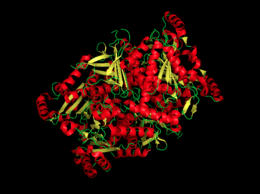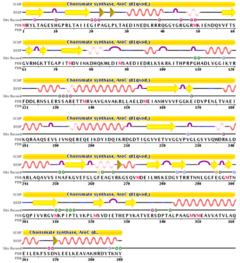General Information

Figure 1. A cartoon image of chorismate synthase.
Scientific Name: Aquifex aeolicus
Genus: Aquifex
Gene: Aroc
Formula weight: 43494.9 Da
Classification: Lyase
Length: 388 residues
Isoelectric point: 5.5
Chains: A,B,C,D
Contagious diseases are increasingly becoming a major public health issue. The shikimate pathway is often used for the advancement of antimicrobial mixures to fight against these diseases. This process only takes place in prokaryotes, fungi and plants. Chorismate synthase is the enzyme that is used in the shikimate pathway, which catalyzes the coversion of phosphoenol pyruvate to chorismate. Chorismate Synthase is an enzyme part of the lyase family. Studying this enzyme and the roles that it plays in many diseases, inhibition of this reaction can lead to oral treatment for infectious diseases and further growth. This enzyme is responsible for catalyzing the following reversible reaction:
5-enolpyruvylshikimate-3-phosphate <--> Chorismate + Phosphate.
Structural Content
Chorismate synthase is a homo 4-mer structure, which is composed of four identical monomer subunits. The crystal structure of chorismate synthase was solved at 2.0 Å using the multiwavelength anomalous dispersion (MAD) method. Each monomer within the structure has a β-α-β fold motif. One of the four monomers differs in structure slight close to the active site. This difference makes the active site a lot more accessible, making this monomer an “open” conformation. The monomer structure is composed of 35% (17 helices) and 18% (21 strands).

Figure 2. This image is representative of the sequence of chorismate synthase.
All of the beta sheets within each monomer run anti-parallel with one another. Helices are divided into two categories: alpha helices and 3/10 helices. In the structure there are 11 alpha helices and there are 6 3/10 helices. The image to the right displays the sequence of chorismate synthase.
Mechanism
The predicted model is that protonates the monoanionic reduced FMN and then His 17 protonates the leaving inorganic phosphate group of the substrate.




